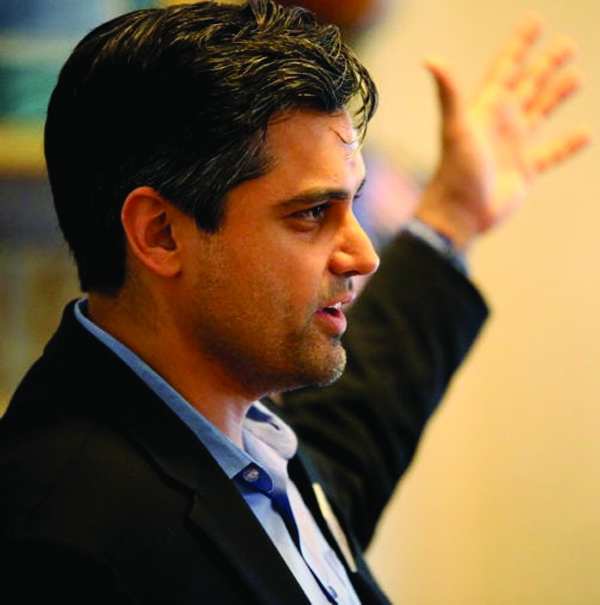Sri Preston Kulkarni: Near Miss to Victory?
 BY BHAMY V. SHENOY
BY BHAMY V. SHENOY
When Sri Preston Kulkarni decided to run last year for Texas 22nd Congressional District (Fort Bend County, Katy, Pearland, etc), many thought that he was too naive. Because it was a safe red district held once by former speaker Tom Delay and then by Pete Olson. No one thought he had a fighting chance.
Had Kulkarni succeeded in unseating the incumbent in a red district he would have created history. In the event, Kulkarni missed the victory just by 4.9% – a remarkable phenomenon which media missed to write about.
Olson had won in 2016 by a margin of 19%. Trump’s margin in Tx-22 against Clinton was only 7.9% which was significantly less than how Obama lost to Romney in 2012 by 25.4%. Despite all odds Kulkarni managed to narrow his loss, a significant shift of 14.1 %. As the election date was nearing, pollsters moved the Tx-22 from red to purple to blue.
In many aspects, near miss victory of Kulkarni is comparable to that of Beto O’Rourke losing to Ted Cruze. Beto lost just by 2.6% but with a smaller shift of 13.4% versus 14.1 % for Kulkarni. While Beto was not new to politics having served as Congressman three times, Kulkarni was a novice in politics. Since there are far more races for the house of representatives than for the senate, Kulkarni’s near miss victory inTx-22 was not highlighted neither in Texas nor in the US.
Things are changing now. Democratic party at national level has started to give more attention to Tx-22. Supporters of Kulkarni have renewed their confidence in their candidate and are holding meetings to come up with new strategies. A producer has come forward to make a promotional video for Netflix on the incredible achievement of Kulkarni. How did Kulkarni catch the imagination of his voters?
To get a better appreciation, it is necessary to discuss his background, his platform, endorsement by Houston Chronicle and finally the unique character of his district. His opponent called him a ‘carpetbagger’ while he is a descendant of Sam Houston from his mother side and he is also an inheritor of India’s civilizational values of “simple living and high thinking” and respect for all religions from his father who is an immigrant from India.
Kulkarni has spent his entire life serving his family, community, and country. A graduate of UT-Austin and Harvard, he served nearly 15 years as a Foreign Service Officer in Jamaica, Taiwan, Russia, Israel, and Iraq. He speaks Spanish, Russian, Hindi, Hebrew, and Chinese.
He took a year off from his college to assist his father who was suffering from Cancer. He was repulsed by Nazi rally in Charlottesville screaming for white supremacy. He felt an urge to get involved to stop the tearing apart of American social fabric. He decided to leave what is certainly an enviable position to plunge into politics. Many enter politics only after ensuring economic independence. But he decided to take the challenge of making the US free from the “ unfortunate disease of intolerance and divisiveness” which is eating into its vitals currently.
His election platform during the last election was progressive and embraced tax fairness and living wage, criminal justice reform, and support for a single-payer health care system. He promised to fight to make sure that no man, woman, or child in Texas’ 22nd district is without health care, that public schools are well-funded and safe from gun violence, that veterans are cared for, that we prioritize scientific evidence over politics on addressing climate change, and that Social Security and Medicare are protected.
Houston Chronicle while endorsing Kulkarni stated that “overall, Olson has come to represent all the worst instincts of U.S. politics while Kulkarni represents our politics at its best”. Such an overwhelming and enthusiastic endorsement must have also helped Kulkarni in narrowing the winning margin of Olson.
Tx-22 is among the most diverse congressional districts in the country consisting of Indian, Chinese, Pakistani, Vietnamese, Filipino, and other Asian immigrants. The district has the biggest concentration of eligible Asian Americans in all of Texas. While whites are just 34%, others account for 66% (African Americans 20%, Hispanics 24%, and Asians 20%). The district should be of academic interest to social and political scientists to study how the country will evolve as whites become a minority in the US as predicted by 2045n.
Kulkarni’s strategy of campaigning based on “ relational organization” by using volunteers who can speak 16 different languages was highlighted in the media. His “relational” volunteers put effort into getting family, friends, co-workers, or other people they know in the community to get out and vote. It is these novel ways that helped to get Asian Americans to vote in large numbers and proved his thesis correct. When he started to campaign he was told not to bother with the Asian Community because they don’t vote. His response was “may be they don’t vote because we don’t bother ”.
While Kulkarni did just about every thing right, he might not have been effective in applying “relational organization” to white and latino voters. More than likely by analyzing precinct votes, he and his volunteers must have come to the conclusion that such an oversight/blunder should be corrected during the future campaigns.
If Kulkarni decides to contest again in Tx-22 in 2020, psephologists will have an easy time to predict. Extrapolation has often failed. However in Kulkarni’s case it will not. This is because of the diversity of Tx-22 and also the unique campaign strategy of contacting voters in 16 languages. All indications are that Kulkarni would contest. And this time he will win.
